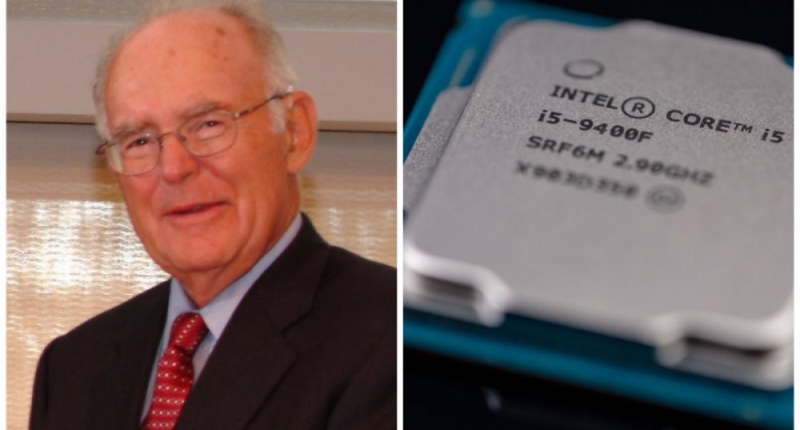Gordon Moore, co-founder of Intel, passed away at the age of 94. He co-founded Fairchild Semiconductor and played a central role in the development of the first commercially viable integrated circuits. Moore is famous for his 1965 prediction, known as Moore’s Law, which stated that the number of transistors on an integrated circuit would double every year. In 1975, he revised the estimate to doubling every two years for the next 10 years, which drove the exponential growth of the semiconductor industry. Moore was also a passionate philanthropist, and together with his wife, established the Gordon and Betty Moore Foundation, which has donated more than $5.1 billion to charitable causes since its founding in 2000. He received several prestigious awards, including the National Medal of Technology and the Presidential Medal of Freedom. Moore is survived by his wife, two sons, and four grandchildren.
Intel co-founder Gordon Moore has passed away at the age of 94. The news of his demise was announced by Intel and the Gordon and Betty Moore Foundation. According to the foundation, Moore passed away peacefully on March 24, 2023, surrounded by his family at his home in Hawaii.
Moore, along with his longtime colleague Robert Noyce, founded Intel in July 1968. Initially, Moore served as executive vice president until 1975, when he took over as president. In 1979, he was named chairman of the board and chief executive officer, a position he held until 1987, when he relinquished the CEO position but continued as chairman. He became chairman emeritus in 1997, stepping down in 2006.
Apart from his contributions to the technology industry, Moore also dedicated his time and resources to philanthropy, with a focus on environmental conservation, science, and patient care improvements. He and his wife, Betty, established the Gordon and Betty Moore Foundation, which has donated more than $5.1 billion to charitable causes since its inception in 2000.
Foundation president Harvey Fineberg paid tribute to Moore, stating that those who worked with him would always be inspired by his wisdom, humility, and generosity. He added that Gordon’s vision and life’s work enabled phenomenal innovation and technological advancements that shape our everyday lives. However, his contributions to the technology industry are only part of his legacy. His and Betty’s philanthropic efforts will continue to shape the world for generations to come.
Intel CEO Pat Gelsinger acknowledged Moore’s immense contribution to the technology industry, stating that he defined it through his vision and insight. Moore was instrumental in revealing the power of transistors, inspiring technologists and entrepreneurs for decades. He further added that Intel remained inspired by Moore’s Law, and they intend to pursue it until the periodic table is exhausted. Gelsinger expressed his humility in carrying Moore’s legacy forward, saying that his career and much of his life took shape within the possibilities fueled by Moore’s leadership at the helm of Intel.
Chairman of Intel’s board of directors, Frank D. Yeary, described Moore as a brilliant scientist and one of America’s leading entrepreneurs and business leaders. He added that it was impossible to imagine the world we live in today without the contributions of Gordon Moore. He will always be an inspiration to the Intel family, and his thinking will remain at the core of Intel’s innovation culture.
Andy Bryant, former chairman of Intel’s board of directors, paid tribute to Gordon Moore, calling him a brilliant scientist, a straight-talker, and an astute businessperson. Moore sought to make the world a better place and always did the right thing. Bryant is grateful that Moore’s legacy lives on in the culture of the company he helped to create.
Before establishing Intel, Moore and Robert Noyce played central roles in the first commercial production of diffused silicon transistors and later the world’s first commercially viable integrated circuits, while at Fairchild Semiconductor. The two had previously worked together under William Shockley, the co-inventor of the transistor and founder of Shockley Semiconductor. Upon striking out on their own, Moore, Noyce, and future Intel CEO Andy Grove built Intel into one of the world’s great companies, becoming known as the “Intel Trinity.” Their legacy continues to this day.
Moore famously predicted in 1965 that the number of transistors on an integrated circuit would double every year, a prediction that came to be known as Moore’s Law. With his 1965 prediction proven correct, in 1975, Moore revised his estimate to the doubling of transistors on an integrated circuit every two years for the next ten years. This idea of chip technology growing at an exponential rate, continually making electronics faster, smaller, and cheaper, became the driving force behind the semiconductor industry and paved the way for the ubiquitous use of chips in millions of everyday products.
In 2022, Intel’s CEO Pat Gelsinger announced the renaming of the Ronler Acres campus in Oregon, where Intel teams develop future process technologies, to Gordon Moore Park at Ronler Acres. The RA4 building, which is home to much of Intel’s Technology Development Group, was also renamed The Moore Center, along with its café, The Gordon. Gelsinger stated that he can think of no better way to honor Gordon and the profound impact he’s had on this company than by bestowing his name on this campus.
Gordon Earle Moore was born in San Francisco on January 3, 1929, to Walter Harold and Florence Almira “Mira” (Williamson) Moore. Moore was educated at San Jose State University, the University of California at Berkeley, and the California Institute of Technology, where he was awarded a Ph.D. in chemistry in 1954.
Gordon Moore began his research career at the Johns Hopkins Applied Physics Laboratory in Maryland before joining Shockley Semiconductor upon his return to California in 1956. In 1957, Moore, along with Robert Noyce and six other colleagues from Shockley Semiconductor, co-founded Fairchild Semiconductor, a division of Fairchild Camera and Instrument. Eleven years later, Moore and Noyce co-founded Intel, which brought them immense financial success.
Moore was a passionate philanthropist who sought to make the world a better place for future generations through his philanthropic work and aspirations. Together with his wife, he formed the Moore Family Foundation, which eventually led to the creation of the Gordon and Betty Moore Foundation in 2000. Impact and measurement were hallmarks of his philanthropic work.
Moore was a recipient of several prestigious awards, including the National Medal of Technology from President George H.W. Bush in 1990 and the Presidential Medal of Freedom, the highest civilian honor in the US, from President George W. Bush in 2002.
Apart from his contributions to the technology industry and philanthropy, Moore was also a member of the National Academy of Engineering, a Fellow of the Royal Society of Engineers, and a Fellow of the Institute of Electrical and Electronics Engineers. He served as the chairman of the board of trustees of the California Institute of Technology and continued as a Life Trustee.
After retiring from Intel in 2006, Moore split his time between California and Hawaii. He served as the chairman of the board for the Gordon and Betty Moore Foundation until transitioning to chairman emeritus in 2018. Moore also served as a member of the board of directors of Conservation International and Gilead Sciences, Inc.
Moore married Betty Irene Whitaker in 1950, and she survives him. He is also survived by his sons, Kenneth and Steven, and four grandchildren.
Don’t miss interesting posts on Famousbio









